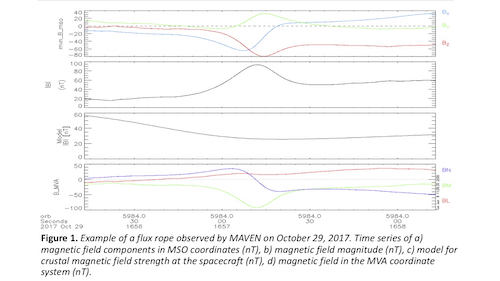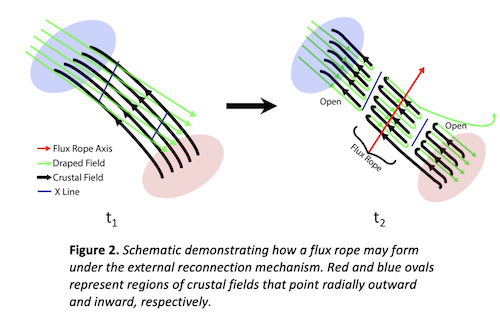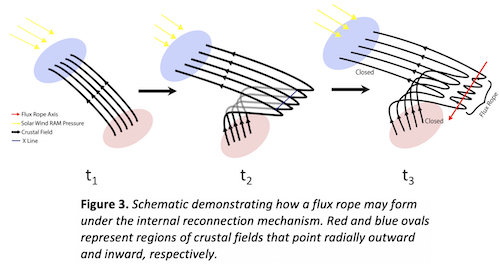Evidence of Low-Altitude Magnetic Flux Ropes Formed by Three Distinct Mechanisms Using Observations from MAVEN
- 1Department of Climatology and Space Sciences and Engineering, University of Michigan, Ann Arbor, MI, USA (@umich.edu)
- 2NASA Goddard Space Flight Center, Greenbelt, MD, USA (@nasa.gov)
- 3University of California, Berkeley, CA, USA (@berkeley.edu)
- 4Laboratory of Atmospheric and Space Physics, University of Colorado, Boulder, CO, USA (@colorado.edu
Here we analyze magnetic flux ropes in the ionosphere of Mars in order to understand their formation mechanism and contribution to atmospheric escape. Detected at objects throughout the solar system, flux ropes are a well-documented magnetic field phenomenon characterized by a filament of highly twisted magnetic field with a strong axial core and weaker outer helical wraps. The ubiquity of flux rope observations despite the diversity of plasma environments in which they form along with the subsequent properties of the flux ropes (radius, orientation etc.), suggests that a variety of plasma physics processes may form these magnetic field structures. Planetary flux ropes at intrinsic magnetospheres are commonly thought to form at the dayside magnetopause due to reconnection between the IMF and the global intrinsic magnetic field or in the cross-tail current sheet when the magnetic fields in the two lobes reconnect. However, flux ropes are also observed at planets in which intrinsic magnetic fields are absent (i.e. Venus) or localized (i.e. Mars). Flux rope formation in the Martian magnetosphere is of particular interest due to the localized crustal magnetic anomalies. In the southern hemisphere, the crustal anomalies are strong (100-1000 nT at the surface) protruding into space creating a “mini-magnetospheric” interaction between the IMF and the crustal anomalies similar to the dayside magnetopause of magnetized planets. In the northern hemisphere, the crustal anomalies are weaker, and do not inhibit the IMF flux tubes from penetrating deep into the ionosphere, creating a plasma environment similar to Venus.
Flux ropes play a role in two classes of fundamental processes at Mars: (1) the rapid reconfiguration of magnetospheric magnetic fields and the acceleration of charged particles, and (2) atmospheric and magnetospheric mass loss through plasma channeling and entrainment in their helical wraps and escape down the magnetotail. While case studies of flux ropes have been carried out at Mars, a comprehensive survey of ionospheric flux ropes and their formation mechanisms is required to better understand the solar-wind magnetospheric interaction at the planet. Here, we present the first survey of flux ropes at Mars with evidence for the flux ropes having been formed by 3 distinct formation mechanisms: External Reconnection (ER) between the draped IMF and crustal anomalies, Internal Reconnection (IR) between the crustal anomalies themselves, and Boundary Wave Instabilities (BWI) similar to those believed to operate at Venus.

We identified 171 magnetic flux ropes observed in the Mars Atmosphere and Volatlie EvolutioN (MAVEN) measurements. Using magnetic field data taken by the magnetometer (MAG) instrument, we applied Minimum Variance Analysis (MVA) to identify flux ropes by their characteristic increase in total field magnetic field strength coinciding with the inflection point of a bipolar signature created by the surrounding helical wraps (Figure 1). These flux ropes display a wide range in core field intensity (5 - 110 nT), location in latitude (-70° - +70°), and solar zenith angle (15°- 140°). The Solar Wind Electron Analyzer (SWEA) instrument onboard MAVEN measures superthermal (>1eV) electrons at a 4 second cadence. We use the fluxes of these electrons compared to the local magnetic field orientation to parameterize the likelihood of a presence of a loss cone. This parameter is known known as a pitch angle distribution (PAD) score. The energy distribution of the electrons is compared to an expected distribution for the photoelectrons at Mars to parameterize the likelihood that the measured electrons are composed of primarily photoelectrons or solar wind electrons; this is known as the shape parameter. These two parameters combine to provide an estimation of the local magnetic topology at the spacecraft. We performed this analysis on our collection of flux ropes and the surrounding environment to determine the formation mechanism of the flux rope.

In the ER flux rope formation mechanism, the draped IMF and a crustal anomaly undergo multiple X-line reconnection. If a flux rope were formed via the ER mechanism, the flux rope would contain both solar wind electrons and photoelectrons, and it would be surrounded by open magnetic field lines, as shown in Figure 2. Thus, a flux rope that were created by the ER mechanism would show an open topology score surrounding the flux rope, with a mixture of solar wind and photoelectron shape parameters inside the structure. 49 (29%) flux ropes are consistent with this formation mechanism. In the IR formation mechanism, a crustal magnetic field loop is distorted due to an increase in solar wind pressure. This distortion may lead to the crustal fields overlapping and reconnecting on themselves in a single X-line as seen in Figure 3. In this case, the flux rope would be found downstream of the subsolar point, surrounded by closed magnetic topology, and contain exclusively photoelectrons.

Figure 4 shows an example of an IR formation mechanism flux rope consistent with this topology projected onto a model of the crustal magnetic fields of Mars. We can see the flux rope axis (red arrow) points perpendicular to radial streamlines emanating out from the subsolar point (yellow triangle) to the flux rope detection point (red diamond), which is also in agreement with the schematic shown in Figure 3. 88 (51%) of flux ropes are consistent with this formation mechanism. The development of large-amplitude waves, most probably Kelvin-Helmholtz (KH), on the boundary between the fast tailward flows in the magnetosheath and the much more slowly moving ionospheric plasma may also form flux ropes at Mars. We characterize this type of flux rope as formed through the BWI mechanism. They contain primarily solar wind electrons, and occur near the draped magnetic topology found in the magnetosheath. 16 (9%) of flux ropes are consistent with this this formation mechanism.
Our classification of the processes responsible for flux ropes at Mars will further our understanding comprise the complex coupling between the Martian magnetosphere and atmosphere.
How to cite: Bowers, C., Slavin, J., DiBraccio, G., Poh, G. K., Xu, S., Brain, D., Espley, J., and Mitchell, D.: Evidence of Low-Altitude Magnetic Flux Ropes Formed by Three Distinct Mechanisms Using Observations from MAVEN, Europlanet Science Congress 2020, online, 21 Sep–9 Oct 2020, EPSC2020-413, https://doi.org/10.5194/epsc2020-413, 2020.

